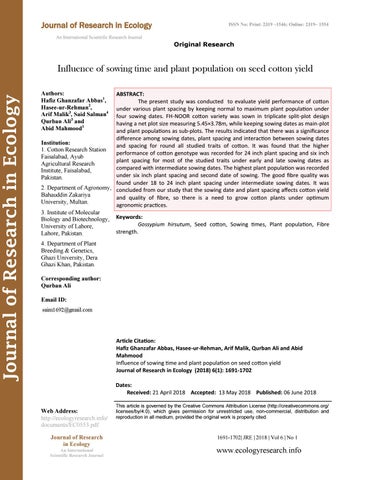Journal of Research in Ecology
Journal of Research in Ecology
ISSN No: Print: 2319 –1546; Online: 2319– 1554
An International Scientific Research Journal
Original Research
Influence of sowing time and plant population on seed cotton yield Authors: Hafiz Ghanzafar Abbas1, Hasee-ur-Rehman2, Arif Malik3, Said Salman4 Qurban Ali3 and Abid Mahmood1
ABSTRACT: The present study was conducted to evaluate yield performance of cotton under various plant spacing by keeping normal to maximum plant population under four sowing dates. FH-NOOR cotton variety was sown in triplicate split-plot design having a net plot size measuring 5.45×3.78m, while keeping sowing dates as main-plot and plant populations as sub-plots. The results indicated that there was a significance difference among sowing dates, plant spacing and interaction between sowing dates Institution: and spacing for round all studied traits of cotton. It was found that the higher 1. Cotton Research Station performance of cotton genotype was recorded for 24 inch plant spacing and six inch Faisalabad, Ayub plant spacing for most of the studied traits under early and late sowing dates as Agricultural Research compared with intermediate sowing dates. The highest plant population was recorded Institute, Faisalabad, under six inch plant spacing and second date of sowing. The good fibre quality was Pakistan. found under 18 to 24 inch plant spacing under intermediate sowing dates. It was 2. Department of Agronomy, concluded from our study that the sowing date and plant spacing affects cotton yield Bahauddin Zakariya and quality of fibre, so there is a need to grow cotton plants under optimum University, Multan. agronomic practices. 3. Institute of Molecular Biology and Biotechnology, Keywords: Gossypium hirsutum, Seed cotton, Sowing times, Plant population, Fibre University of Lahore, strength. Lahore, Pakistan. 4. Department of Plant Breeding & Genetics, Ghazi University, Dera Ghazi Khan, Pakistan. Corresponding author: Qurban Ali Email ID:
Article Citation: Hafiz Ghanzafar Abbas, Hasee-ur-Rehman, Arif Malik, Qurban Ali and Abid Mahmood Influence of sowing time and plant population on seed cotton yield Journal of Research in Ecology (2018) 6(1): 1691-1702 Dates: Received: 21 April 2018 Accepted: 13 May 2018 Published: 06 June 2018 Web Address: http://ecologyresearch.info/ documents/EC0553.pdf Journal of Research in Ecology An International Scientific Research Journal
This article is governed by the Creative Commons Attribution License (http://creativecommons.org/ licenses/by/4.0), which gives permission for unrestricted use, non-commercial, distribution and reproduction in all medium, provided the original work is properly cited.
1691-1702| JRE | 2018 | Vol 6 | No 1
www.ecologyresearch.info
